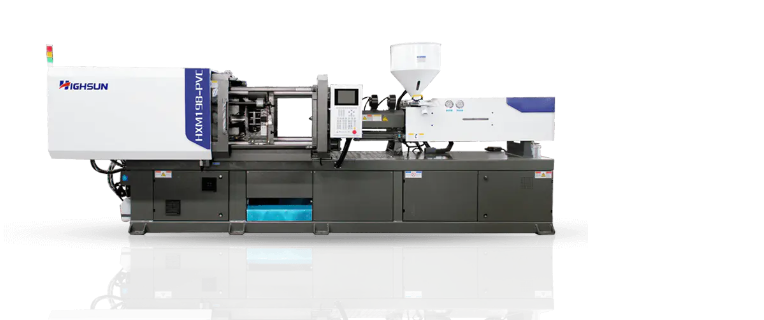Plastic injection machines are key equipment in the production of plastic products and are widely used in industries such as home appliances, automobiles, and packaging. However, during long-term use, plastic injection molding machines may experience various malfunctions, affecting production efficiency and product quality. Understanding common malfunction types and quick repair methods can help companies reduce downtime and improve production efficiency.
1. Common Malfunctions and Repair Methods of Plastic Injection Molding Machines
(1) Insufficient Injection (Material Shortage)
Fault Phenomenon: The plastic product is not fully filled, resulting in material shortage or short shots. Possible causes:
The barrel temperature of the plastic injection molding machine is too low, resulting in insufficient plastic melting.
Insufficient injection pressure or speed, unable to completely fill the mold.
Poor mold venting, gas obstructing plastic flow.
Clogged nozzle or screw, affecting plastic delivery.
Repair methods:
Check and adjust the barrel temperature to ensure sufficient plastic melting.
Appropriately increase injection pressure and injection speed.
Clean the mold venting groove or add venting holes.
Disassemble the nozzle and screw, and clean residual plastic.
(2) Product flash (burrs)
Fault phenomenon: Excess plastic appears on the edges of plastic products, affecting product appearance and dimensional accuracy.
Possible causes:
Insufficient clamping force of the plastic injection molding machine, mold not fully closed.
Mold wear or deformation, resulting in incomplete closure.
Injection pressure too high, plastic overflows from the mold cavity.
Repair methods:
Check and adjust the clamping force to ensure the mold is tightly closed.
Check mold wear, repair or replace if necessary.
Appropriately reduce injection pressure to avoid overfilling.
(3) Product shrinkage (dents)
Fault phenomenon: Dents or shrinkage cavities appear on the surface of plastic products.
Possible causes:
Insufficient holding time in the plastic injection molding machine, resulting in uneven cooling and shrinkage of the plastic. Insufficient injection volume, leading to inadequate shrinkage compensation. Insufficient cooling time, resulting in incomplete curing of the plastic.
Repair methods:
Extend the holding time to ensure sufficient shrinkage compensation of the plastic. Increase the injection volume or increase the injection pressure. Optimize the cooling system and extend the cooling time.
(4) Screw cannot inject or injection is not smooth
Fault phenomenon: The screw of the plastic injection molding machine rotates but does not dispense material, or the injection action is abnormal.
Possible causes:
Barrel temperature is too low, resulting in insufficient melting of the plastic. Screw or nozzle is blocked. Hydraulic system pressure is insufficient.
Repair methods:
Check and adjust the barrel temperature. Disassemble the nozzle and screw, and clean any residual plastic. Check the hydraulic oil pressure and whether the oil circuit is normal.
(5) Oil temperature is too high
Fault phenomenon: The hydraulic system temperature of the plastic injection molding machine rises abnormally, affecting the stability of the equipment operation.
Possible causes:
Cooling system malfunction, such as cooler blockage or water pump damage
Hydraulic oil contamination or insufficient oil level
Equipment operating under high load for extended periods
Repair methods:
Inspect the cooling system, clean the cooler or replace the water pump
Replace or replenish the hydraulic oil, ensuring cleanliness
Arrange production plans reasonably to avoid overloading the equipment
(6) Abnormal mold opening and closing
Fault phenomenon: The mold of the plastic injection molding machine cannot open and close normally, or moves slowly or is stuck.
Possible causes:
Wear or insufficient lubrication of the mold locking mechanism
Hydraulic oil circuit blockage or insufficient pressure
Electrical control system malfunction
Repair methods:
Inspect the mold locking mechanism, replenish lubricating oil or replace worn parts
Inspect the hydraulic system, clean the oil circuit or adjust the pressure
Check the electrical control signals to ensure that the solenoid valves and sensors are working properly
(7) Product sticking to the mold (difficult demolding)
Fault phenomenon: The plastic product sticks to the mold and is difficult to eject.
Possible Causes:
Insufficient draft angle of the mold; Damaged or poorly lubricated ejector mechanism; Mold temperature too high or insufficient cooling.
Repair Methods:
Optimize mold design, increase draft angle; Inspect ejector mechanism, repair or lubricate; Adjust mold temperature to ensure uniform cooling.

2. Preventive Maintenance Recommendations for Plastic Injection Molding Machines
To reduce malfunctions, regular maintenance of plastic injection molding machines is recommended:
Daily Inspection: Lubricate moving parts, check hydraulic oil level and temperature.
Weekly Maintenance: Clean mold and nozzle, check electrical wiring.
Monthly Maintenance: Replace hydraulic oil filter, check screw wear.
Annual Overhaul: Comprehensive inspection of hydraulic system, electrical system, and mechanical structure.
Faults in plastic injection molding machines may be caused by mechanical, hydraulic, electrical, or improper process parameters. Quick diagnosis and repair can effectively reduce downtime and improve production efficiency. Furthermore, regular maintenance and optimization of process parameters can extend the service life of plastic injection molding machines and ensure stable production operation.
 ENG
ENG  English
English русский
русский Español
Español Português
Português عربى
عربى















 +86-188 6861 6288
+86-188 6861 6288 haixiong@highsun-machinery.com
haixiong@highsun-machinery.com No.36 Yongjiang South Road, Beilun District. Ningbo City, 315800, China
No.36 Yongjiang South Road, Beilun District. Ningbo City, 315800, China